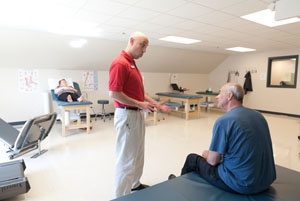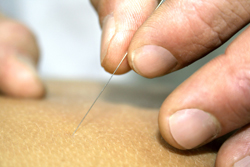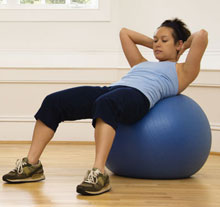
Causes of hip pain | Understanding symptoms | Nonsurgical treatments | Surgical options | Hip prevention
The key to keeping a hip problem at bay is to stay relatively active and to eat right. The most recent government report notes that 56 percent of Americans are overweight. This is bad news for our hips and knees.
Scientifically speaking, our hips form and develop in mass and strength in proportion to the amount of weight our body was designed to hold. So, if you are a small woman, your hips are meant to hold a smaller amount of weight than if you are a six-foot tall man. Although the body is very adaptable and can learn to hold different weights, a point can be reached where the body is simply not comfortable supporting the excess weight.
Let's talk BMI, or Body Mass Index. BMI is the number you come up with when you divide how much you weigh in kilograms by how tall you are in centimeters squared. The number you come up with is your BMI. A BMI between 18.5 and 25 is considered in the normal range. A BMI above 25 is considered overweight and a BMI of 30 or more is classified as obesity. To find your BMI, there are several calculators on the Internet including the BMI recommendations from the Surgeon General. Click here to calculate your BMI.
Losing weight can provide instant relief for the hips. Although we are constantly inundated with new diet fads, remember that logically, the way to lose weight is to consume fewer calories than we burn and the way to maintain weight is to burn approximately the same number of calories that we burn.
Although in reality, this method can be harder to follow than it is to understand, once we build healthy habits, this lifestyle will become easier and easier to maintain. Some diets help you to do this. Others are shams. Be cautious. Anything that seems to good to be true, probably is.
If you have arthritis, there are pain aggravators that should be avoided. For instance, paprika, pepper, tobacco, cayenne, eggplant, large amounts of potatoes and tomatoes can irritate your arthritis because these foods have alkaloids that prevent the repair of collagen and cartilage. Aspartame (found in diet sodas and artificial sweeteners) can also worsen arthritis since in causes inflammation in the joints when regularly consumed.
In study after study, it seems almost innumerable health benefits can be accumulated from eating a diet rich in fiber and complex carbohydrates found in vegetables, whole wheat and fruits. Once again, hips also benefit from this diet.

It is also important to incorporate exercise into your routine if you have hip pain. Although it may seem like a Catch-22 (you cannot exercise because your hip hurts, and your hip hurts more because you cannot exercise) strengthening the leg muscles can be crucial in alleviating hip pain.
The more support the muscles can offer, the less stress and therefore less pain. Please refer to our online exercise library, which will show you several hip strengthening exercises. Also, if your hip hurts and you want to start up an exercise routine, why not try a stationary bike or swimming? While running or stair climbing can be taxing to the hips, the stationary bike and swimming are both excellent cardiovascular activities that only minimally put pressure on the hips.
Non-Steroidal Anti-Inflammatory medication, or NSAID's, such as ibuprofen (Advil, Nuprin and Motrin IB) help reduce swelling and inflammation and can be quite helpful to a torn ligament. The ibuprofen also helps mask the pain of a hip injury. Use NSAID's cautiously, however, as taking them regularly over a long period of time can cause ulcers or other gastro-intestinal problems. 
Just remember that while using NSAID's, you should also be taking other precautions to heal your pain. COX-2 inhibitors such as Celebrex by Searle and Vioxx by Merck can help lessen the stiffness brought on by arthritis pain. Vioxx can helps manage both osteoarthritis and rheumetoid arthritis pain. While they are able to help with the pain, they also might make it difficult for the body to heal ulcers, so be sure to consult with your doctor to make sure this is the right treatment for you.
Another anti-inflammatory that can be useful are enzymes. The FDA has labeled them GRAS (or generally regarded as safe) which means they can be used to treat hip pain with little to no side effects.
This is an easy to remember four-step formula for treating a hip injury that is incurred from activity.
Jane E. Brody, "Personal Health" columnist for The New York Times, says that European researchers have shown that glucosamine and chondroitin taken by mouth find their way to articular cartilage, and biopsies of some treated patients have shown structural improvements in damaged cartilage. Those who suffer from arthritis pain can find this particularly encouraging. These compounds are already found in the human body and they protect cartilage like a cushion at the ends of the bones. They can structurally improve in damaged cartilage. Glucosamine is able to repair joints by providing the elements the joints need to repair the damage caused by injury or arthritis. The joint cartilage absorbs glucosamine and it helps to form cartilage by capping the ends of bones. Glucosamine also keeps the mechanisms that build and deteriorate cartilage balanced, thereby preventing unnecessary, or untimely tissue loss. Chondroitin keeps the enzymes in the hip from eating away at cartilage, and it helps other enzymes in moving the flow of nutrients to the cartilage in the hip. In test tube studies, chondroitin has been proven to stop certain enzymes from breaking down cartilage further.

Methyl-Sulfonyl-Methane (MSM) is a sulfide that the body naturally produces. Those suffering from hip pain may find that it helps lessen their pain. MSM is, for the most part, safe. It increases the flow of harmful substances out of the cells and prevents pressure buildup in the cells, which causes inflammation in the joints. MSM is most widely used as an anti-inflammatory for joint and hip pain associated with arthritis.
Although the body produces MSM, additional MSM is found in other foods such as milk, meat, vegetables, fruit, and seafood. However, due to the abundance of processed foods, it can be hard to get the recommended dosage. Steamed foods, washing foods, and aging can also reduce MSM levels.
Shark cartilage has been shown to lessen the pain and stiffness in hips. This is because it contains mucopolysaccharides, powerful anti-inflammatory molecules. Shark cartilage is available in capsule form that can be taken as a dietary supplement. While it may not completely eliminate the pain, it might help.
Shark cartilage is a nontoxic, natural supplement that contains calcium, phosphorous, and complex carbohydrates. The calcium and phosphorous is easily absorbed into the body, and the complex carbohydrates have been shown to reduce inflammation.
Using shark cartilage, Dr. Joseph Orcasity, a consultant at the University of Miami Medical School, treated a dozen elderly arthritis patients with severe hip pain. He reported that after taking shark cartilage for four weeks, most patients exhibited reduced pain and swelling and increased mobility.
In a recent study, gelatin capsules have been shown to help reduce pain and stiffness in athletes at Ball State University. The concentration of gelatin must be much greater than what is found in a bowl full of Jell-O but it is essentially the same thing. This supplement is classified by the Food and Drug Administration as GRAS (or generally regarded as safe).
Not only can minerals such as boron, copper, manganese, silicon, and zinc help treat osteoarthritis, they can also be beneficial to your health overall. Although many of the foods we eat contain these minerals, they can also be taken as a supplement. Some of these minerals act as anti-inflammatories and others act as antioxidants.
 Vitamins
Vitamins Vitamins can be helpful in alleviating pains associated with rheumatoid arthritis, an autoimmune disorder that attacks tissues in the body. The tissue degeneration causes pain in the joints. Vitamins can help the immune system eliminate these toxins in the body keeping cartilage from breaking down so rapidly.
Taking herbs is sometimes considered archaic or analogous. However, grandmother was right. Herbs are good for your health. Certain herbs such as licorice, ginseng, cat's claw, and echinacea can help the immune system by reducing inflammation as they bolster cell membranes. Other herbs that can help alleviate pains associated with osteoarthritis or rheumatoid arthritis are Chinise skullcap, devil's claw, curcumin, yucca, ginger, and witch hazel.
While in some cases, the treatments listed here do not change the structure of the hip, they can be a great way to manage pain — with virtually no side effects if done correctly. Some of these treatments may be more effective on some people than others. If you would like to seek alternative treatment, try to find something that works the best for you.
Acupressure is an ancient Chinese form of therapy where pressure is applied to the body in order to increase blood circulation and relieve pain. This unique form of massage can relax muscles and compress nerve fibers that cause pain. If you are interested in experimenting with this form of therapy, you can either find a professional acupressure therapist or simply go to the bookstore and find a book that will tell you how to try the techniques at home by yourself or by a partner.
Those suffering from hip pain may find relief from visiting an acupuncture specialist. During acupuncture hair-thin needles are inserted into various parts of the body and are stimulated to alleviate pain in many forms including but not limited to nausea, dental pain, muscle pain, menstrual cramps, and pain from osteoarthritis. This 3000-year-old Chinese art gained credibility in the western world in 1997 when the National Institutes of Health declared it efficacious.
The Chinese believed that by balancing the positive and negative energy in the body, pain relief can be achieved. They found acupuncture to be an effective resource to achieve that balance. Other modern-day doctors believe that acupuncture stimulates pressure points thus releasing relaxing endorphins. Whatever the case may be, acupuncture provides relief to many people suffering from pain.
If you decide to try acupuncture, be sure to have a licensed professional administer the treatment. Also, get a physician's referral for an acupuncturist close to you. An acupuncturist should be certified by the National Commission for the Certification of Acupuncturists. You can obtain a list of certified specialists in your area by calling the American Association of Acupuncture and Oriental Medicine.
Bee Venom Therapy (BVT) is a toxin that is put into a certain part of the body. The toxin is attacked by the immune system making it stronger and more prepared to deal with future toxins. The body in a way creates its own antibody against the bee venom in that area. This therapy be administered only by a practitioner licensed in it.
Spas and whirlpools are sometimes used to improve circulation and relieve chronic pain from the back and joints. Different therapy uses different temperatures of water. Cold water reduces inflammation, cold and warm water improves circulation. Dr. Nooshin K. Darvish, a specialist in hydrotherapy, recommends that patients apply moist heat to the hip for three minutes followed by cool water for one minute. This should bring relief and stimulate circulation.
 Massage
MassageTherapy Massage not only feels good, it is an effective way of relieving pain. A masseuse will increase the circulation of the body through rhythmic hand motion. In sports, massage therapy can be used to prevent strain by warming up athletes prior to a workout. The muscles can also be massaged after a workout to bring blood and oxygen into the muscles to flush out metabolic waste and increase circulation to the muscles to bring them the nutrients they need to heal after strenuous activity.
For those suffering from arthritis, massage can also be very helpful. Massage will help blood circulate in the painful area which brings essential nutrients to the muscles and joints which will help reduce inflammation and can also help break up scar tissue and adhesion which is causing pain.
Reflexology has been used as a method to relieve pain for thousands of years starting in ancient Egyptian culture. The premise is that by massaging the feet or hands, you can help ease pain in another part of your body. By massaging a certain part of your foot, for instance, you may be able to sooth hip pain.

Over the past few years a scientific affirmation has verified the idea of 'mind over matter'. Zen is a method employed by some to shape the mental state and in some ways actually control pain. In our frenetically paced world, all of us need focus and discipline.
Ancient Eastern exercises are have become increasingly popular in the United States over the past few decades. These exercises stress the importance not only of physical agility, but joining the mind and body to have mental control over the physical state. These exercises are not only trendy, they are useful in increasing flexibility and gaining strength, which can help prevent and alleviate pain.